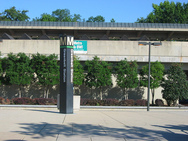Imagine the Green Line to Fort Meade
On Monday night, Prince George’s County voted on its transportation master plan update, including a recommendation to extend the Green Line to Fort Meade.
The master plan calls for creating, extending, or widening several highways throughout the county, greenfield development outside the Beltway, and some other Cold War-era fixes to Prince George’s transportation problems. The county’s ample highways have been described to me by my coworkers as “the only thing worth visiting in Prince George’s County”. As a resident, I disagree wholeheartedly, but it is hard to dispute that many people use the B-W Parkway, I-95, US-50, MD-4, MD-5, and Indian Head Highway as through routes to get to “nicer” exurban communities in Howard, Anne Arundel, and Charles County.
The plan does, however, propose many transit improvements. Most notably, at least for Laurel residents like me, is the Green Line extension proposed through Beltsville, Laurel, and on to Fort Meade. The county’s proposal for this extension doesn’t cater directly to greenfield development like older proposals for the extension that followed I-95 to MD-32 on a circuitous route through southeastern Columbia en route to BWI. The route shown below follows the CSX corridor in Prince George’s County, as indicated in the master plan. If the Green Line is extended to Fort Meade, it would probably look a lot like this:
View Green Line Extension in a larger map.
Here’s a possible list of stations:
- Beltsville (Baltimore Avenue and Powder Mill Road)
- Muirkirk/Konterra (Baltimore Avenue at Muirkirk Road)
- Laurel Lakes (Cherry Lane between Baltimore Avenue and MD 197)
- Laurel (Main Street at First Street)
- Savage/Annapolis Junction (Brock Bridge Road at Dorsey Run Road)
- National Business Park (MD 32 and National Business Pkwy)
- National Security Agency (MD 32 and Canine Road)
- Fort Meade Main Gate (MD 32 and Mapes Road)
- Odenton Town Center (Odenton Road and Morgan Drive)
Fort Meade is the largest job center in the state of Maryland, and it is currently unserved by transit. A Green Line extension would enable reverse commutes from Washington, DC and the Route 1 corridor while facilitating transit-oriented development along Route 1.
Servicing Fort Meade also would meet some of the transportation challenges presented by BRAC’s relocation of 5,700 jobs to Fort Meade. Metro access to the base’s facilities would eliminate the need for massive highway widening around this job center. The existing transit on the corridor, the MARC Camden Line, suffers from poor service because it shares tracks with the CSX freight trains, does not serve Fort Meade, and has not induced any TOD. This alignment would most likely overcome those shortcomings and better integrate northeastern Prince George’s County into the urban fabric of the DC metropolitan area.
Cross-posted on Imagine, DC.

